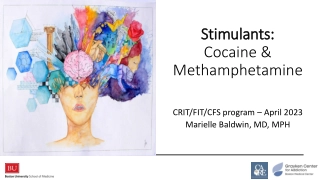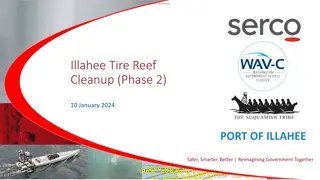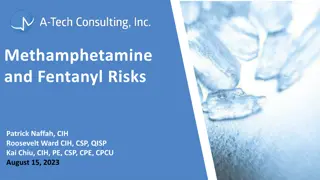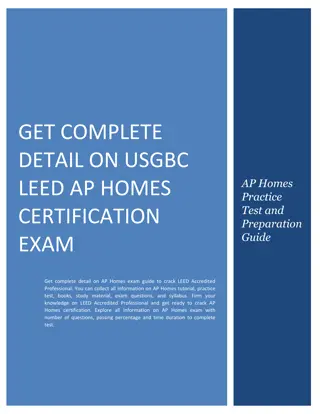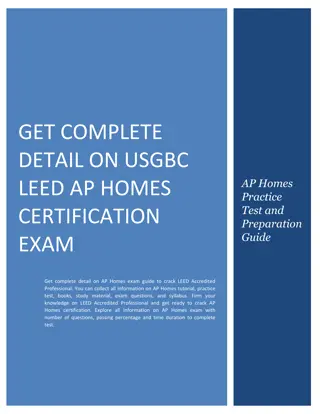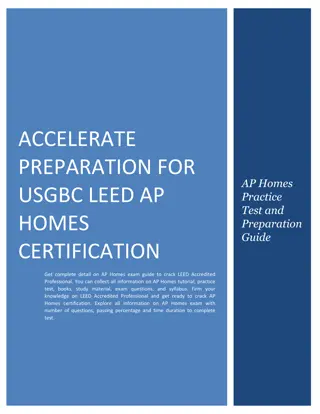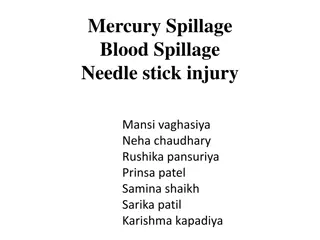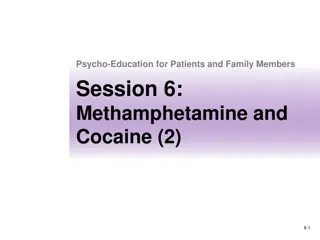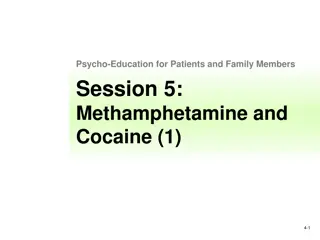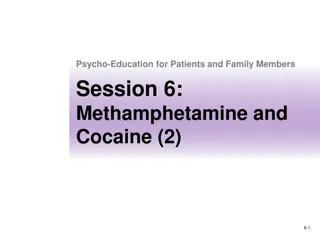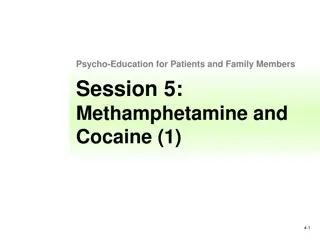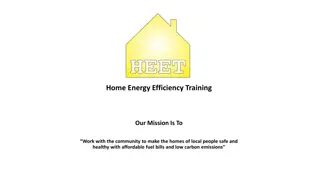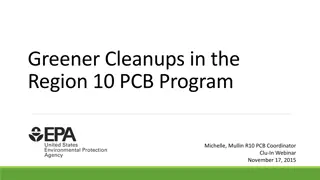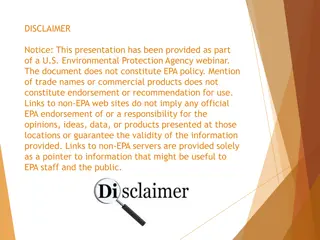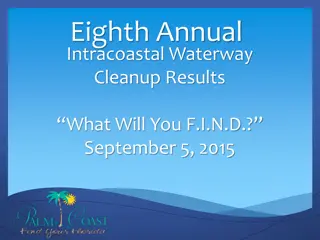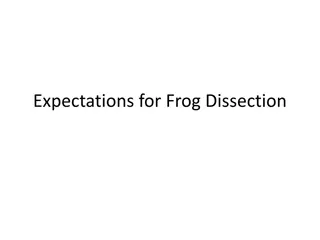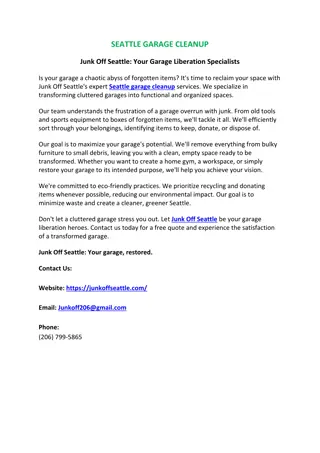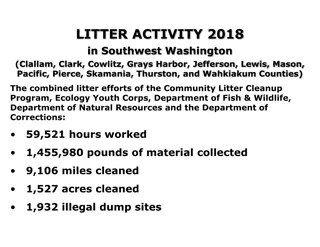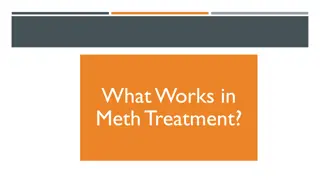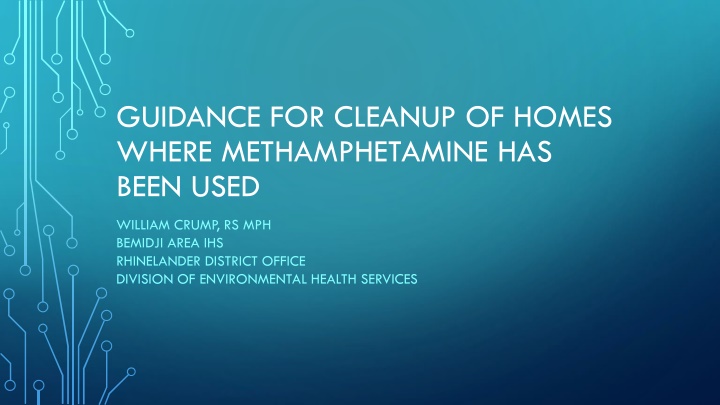
Cleanup Guidance for Homes Post Methamphetamine Use
This guidance presentation by William Crump, RS, MPH from the Bemidji Area IHS Rhinelander District Office Division of Environmental Health Services focuses on the risks, health considerations, and science behind cleaning homes where methamphetamine has been used. It highlights the importance of proper cleanup procedures, worker and resident safety, and the need for additional research to better understand potential health risks associated with low-level methamphetamine exposure.
Download Presentation

Please find below an Image/Link to download the presentation.
The content on the website is provided AS IS for your information and personal use only. It may not be sold, licensed, or shared on other websites without obtaining consent from the author. If you encounter any issues during the download, it is possible that the publisher has removed the file from their server.
You are allowed to download the files provided on this website for personal or commercial use, subject to the condition that they are used lawfully. All files are the property of their respective owners.
The content on the website is provided AS IS for your information and personal use only. It may not be sold, licensed, or shared on other websites without obtaining consent from the author.
E N D
Presentation Transcript
GUIDANCE FOR CLEANUP OF HOMES WHERE METHAMPHETAMINE HAS BEEN USED WILLIAM CRUMP, RS MPH BEMIDJI AREA IHS RHINELANDER DISTRICT OFFICE DIVISION OF ENVIRONMENTAL HEALTH SERVICES
GOAL OF PRESENTATION Provide Overview of Problem Risk vs. Health vs. Science Tribal Concerns Workers Residents and Belongings Re-Occupancy IHS Role Recommended Guidelines and Actions
HISTORY Apple Environmental Training ~2017 Contact from several tribes Employee Health Concerns 8% Hydrogen Peroxide Based Product 1-5% Ethanol Effectiveness of Cleaning Process Testing Methods Policy for Clearance Apple Environmental Meeting EPA Lists Concerns about Hydrogen Peroxide Based Product for Meth and Byproducts
IS OUR RISK FOCUSED CORRECTLY? In contrast to the known effects of first-hand exposure, no data have been reported relating to third-hand exposure situations, which affect a greater majority of the population that is, non-users living in dwellings (whether remediated or not) that had been previously used only for smoking of methamphetamine. Literature currently suggests no available evidence in the scientific or grey literature that low-level methamphetamine exposure, involving levels that may be encountered from skin contact or oral ingestion of residues on household surfaces, poses a health risk in humans. Realistic scenarios of exposure through contact with surface residues, even for toddlers who often put their hands in their mouths, do not suggest that levels would reach close to a threshold where adverse effects would be observed. We note, however, that absence of evidence is not evidence of absence of an effect. There is a clear need for more research and a coordinated inter-agency effort to build up a robust dataset.
HEALTH RISK AND SCIENCE Toxicity assessments and exposure dose models used to establish standards for remediation of former meth labs (which are used in all Federal and State guidelines to guide remediation, and do not distinguish between manufacture and use) have deliberately adopted conservative assumptions, with large (~300-fold) safety margins built in. These margins reflect data gaps and uncertainties in the calculations and are considered precautionary. Taken together, these factors indicate that methamphetamine levels that exceed the guidelines clean-up standard of 1.5 g/100 cm2 should not be regarded as signaling a health risk. Indeed, exposure to methamphetamine levels below 15 g/100 cm2 would be unlikely to give rise to any adverse effects. This level still incorporates a 30-fold safety buffer on a conservative estimate of risk.
RISK IN PERSPECTIVE When considering how to determine whether a risk is high enough to warrant substantial remediation measures, it sometimes helps to compare the risk to other similar risks, and consider how they are dealt with (or not) in society. We do not test for or regulate third-hand smoke residues from cigarettes, which contain carcinogenic polycyclic aromatic hydrocarbons such as benzopyrene, as well as nicotine, which are measurable on indoor surfaces months after the last smoke. Other household hazards such as mold, lead paint and asbestos pose greater health risks than third-hand methamphetamine exposure (at least in a non-meth lab environment). There is DEA and Treasury studies showing that methamphetamine residue can be detected on banknotes, and occasionally at levels close to that found in many houses currently testing positive and deemed to be in need of remediation
OUTCOME OF RISK VS HEALTH VS SCIENCE It is important that guidelines for mitigation measures are proportionate to the risk posed, and that remediation strategies should be informed by a risk- based approach. This means that, because the risk of encountering methamphetamine on residential surfaces at levels that might cause harm is extremely low, testing may not be warranted in routine housing situations. Remediation according to the guidance or standard is appropriate only for identified former meth labs and properties where excessive methamphetamine use, as indicated by high levels of methamphetamine contamination, has been determined.
PERSPECTIVE FOR THIRD HAND RISK Forensic work by the New Zealand Institute for Environmental Science and Research (ESR) suggests that levels of methamphetamine can be assessed against an excessive threshold that is indicative of manufacturing activity. A US study has reported levels typically higher than 25 g/100 cm2, and New Zealand ESR data from 136 meth labs found an average level of 54 g/100 cm2. ESR modelling data suggest that in a 20 m2 (~200 Ft2) room, a very high number of smoke sessions (up to ~1,500) would be required to reach a level of 30 g/100 cm2. This estimate may be conservative given that surface residues decrease over time, which is not accounted for in the modelling. Hence, levels around or exceeding 30 g/100 cm2 are regarded as strongly suggestive of heavy use or manufacturing activity.
RISK BASED ASSESSMENT OF PROPERTIES Testing for methamphetamine in residential properties should not be the default pathway. From a risk perspective, testing is only necessary where meth lab activity is suspected or where very heavy use is suspected. New Zealand has determined there is merit in using tests that rapidly provide a simple positive or negative result in multiple locations for detection of higher levels on site, followed by sensitive testing in targeted areas that produce a positive signal. For example, National Institute for Occupational Safety and Health (NIOSH) t -validated colourimetric tests are available in the US that detect levels >15 g/100 cm2. If methamphetamine is not detected at this level anywhere within a property, there is little cause for concern unless there are other reasons to suspect methamphetamine manufacturing activity. If the screening test shows levels >15 g/100 cm2 , then a more thorough assessment should be conducted to determine whether there is an area of high contamination that needs to be remediated. Where a former meth lab has been identified, remediation should continue to current guidelines as outlined in the EPA Standard for remediation of meth labs.
IMPLICATIONS FOR SCREENING AND REMEDIATION Remediation is certainly warranted if high levels of methamphetamine are present that are indicative of manufacturing activity or excessive smoking. What is a high level? Levels >30 g/100 cm2 are considered by forensic experts to signify that manufacture or high use is likely to have taken place. Testing for lower levels that still suggest relatively high levels of smoking (e.g. >15 g/100 cm2 ) could be used to identify specific areas of contamination that warrant remediation. Remediation includes removal of all potentially contaminated porous materials or items (furnishings, carpets) and cleaning of the contaminated surfaces, using the tribal standards as a guide.
IMPLICATIONS FOR SCREENING AND REMEDIATION Where lower levels are detected, remediation is often not justified. However, as low levels cannot definitively rule out manufacture or heavy use, remediation down to the tribal standard may be prudent if there is also sound reason to suspect previous meth lab activities or heavy use is documented. This would only be as a precautionary measure to remove other toxicants that may be present but not measured.
WORKER EXPOSURE Law Enforcement and Emergency Personnel Policy and Procedures Meth Risk to Employees during Cleanup Chemical Risk to Employees during Cleanup Hydrogen Peroxide and Ethanol
WORKER PPE PPE Not for the Methamphetamine PPE for the ~8% Hydrogen Peroxide and ~5% Ethanol not Meth Meth Contact Risk is Minimal According to EPA and Multiple Studies Detergent Soap and Water Process is Just as Effective EPA also does not have Documented Evidence of By-Products Created when using Peroxide Based Cleaning Agents and does not Recommend use of any Harsh Chemicals for Cleaning Methamphetamine Apple has a Study Conducted by a Private Lab Located in New Zealand indicating By-Products of P2P and Benzoic Acid
TESTING AND CLEANING PRE-SCREENING AND TESTING Record Review Tenant History Police Site Survey Layout to identify testing locations Testing centered around heavy use and branch out from there For pre-remediation sampling, the hypothesis being tested is the site is clean and that there is no evidence of meth or its production. Wipe Sampling Composite Multiple samples combined and treated as a single sample Discrete Individual single samples taken at spatially discrete locations CLEANING Tenant Belongings Tribal housing is responsible for the restoring of the structure to a habitable condition, housing is NOT responsible for the personal belongings of the resident or occupant of the home. Structure Removal of Contaminated Materials Porosity of Materials - Cleanability vs Disposal HVAC Return Air Grills and Filter Areas in Main Unit Encapsulation Remediation Priority Sequence of Cleaning Soap and Water Thorough Process Level may Determine number of cleanings needed Degreaser Based like Simple Green or Dawn No Bleach or other chemicals recommended
EFFECTIVENESS OF CLEANING POST CLEAN TESTING In post-remediation sampling, the hypothesis is that the site has not been thoroughly cleaned. The owner or contractor will seek to prove, through biased sampling, that the site contains contaminant levels that exceed the relevant standard.
WHAT IS CLEAN? If the only concern is methamphetamine use, the health concern about harmful exposures is limited to the methamphetamine itself, and does not include concerns about the other chemicals that can contaminate a residence from a methamphetamine lab. 1) Several studies indicate there is no significant health risk to any family member living in a residence when methamphetamine contamination measures at or below 1.5 g/100 cm2 (California Standard) 2) When methamphetamine contamination measures above 1.5 g/100 cm the housing authority may follow the remediation steps in this guidance as closely as possible to reduce the risk from exposure to methamphetamine residue.
POLICY FOR CLEARANCE AND OCCUPANCY A Tribe or a Tribal Housing Program should determine what levels of residual methamphetamine contamination should be reached before a home is determined to be acceptable for reassignment. This is important to ensure a level is set for housing programs to achieve a clean and safe level when reassigning homes to other occupants. Most state remediation standards are based on analytical detection limits and feasibility they are not health-based standards. It is important to note, however, that these standards are believed to be set at sufficiently conservative levels to still be health-protective. In other words, remediation standards are believed to account for the scientific uncertainty involved in meth lab remediation in the interest of protecting human health and the environment. California Standard = The California health-based standard (California standard) is 1.5 g/100cm2. This number is based on a study of health effects of meth in children the population most at risk to harm from meth residue.
IHS ROLE AND OUTCOMES Meetings with Tribal Housing and Housing Boards to Discuss Guidance and Policy Training of Staff and Responders Guidance Document Assessments Testing Cleanup and PPE Personal Belongings Revision of Guidance Document When Needed as Health vs Risk vs Science Changes
CONSIDERATIONS ASSESSMENTS PROCESS FOR HOMES Lab vs Use Different Set of Hazards Lab vs Use Police and Other Services Play Role BASELINE FOR ALL UNITS Purpose for Baseline Risk vs Health vs Science TRIBAL HOUSING POLICIES Risk vs Health vs Science Set a limit HIGH >30 Action Level >15 Clearance <1.5 METHAMPHETAMINE TESTING NIOSH/CDC Colormetric Testing Kit >15 ug/cm3 CLEANING Limits for Use of Apple Products vs Soap and Water Clearance Levels of Homes and Housing Policy
QUESTIONS??? WILLIAM CRUMP WILLIAM.CRUMP@IHS.GOV 715-365-5112 715-550-8434

